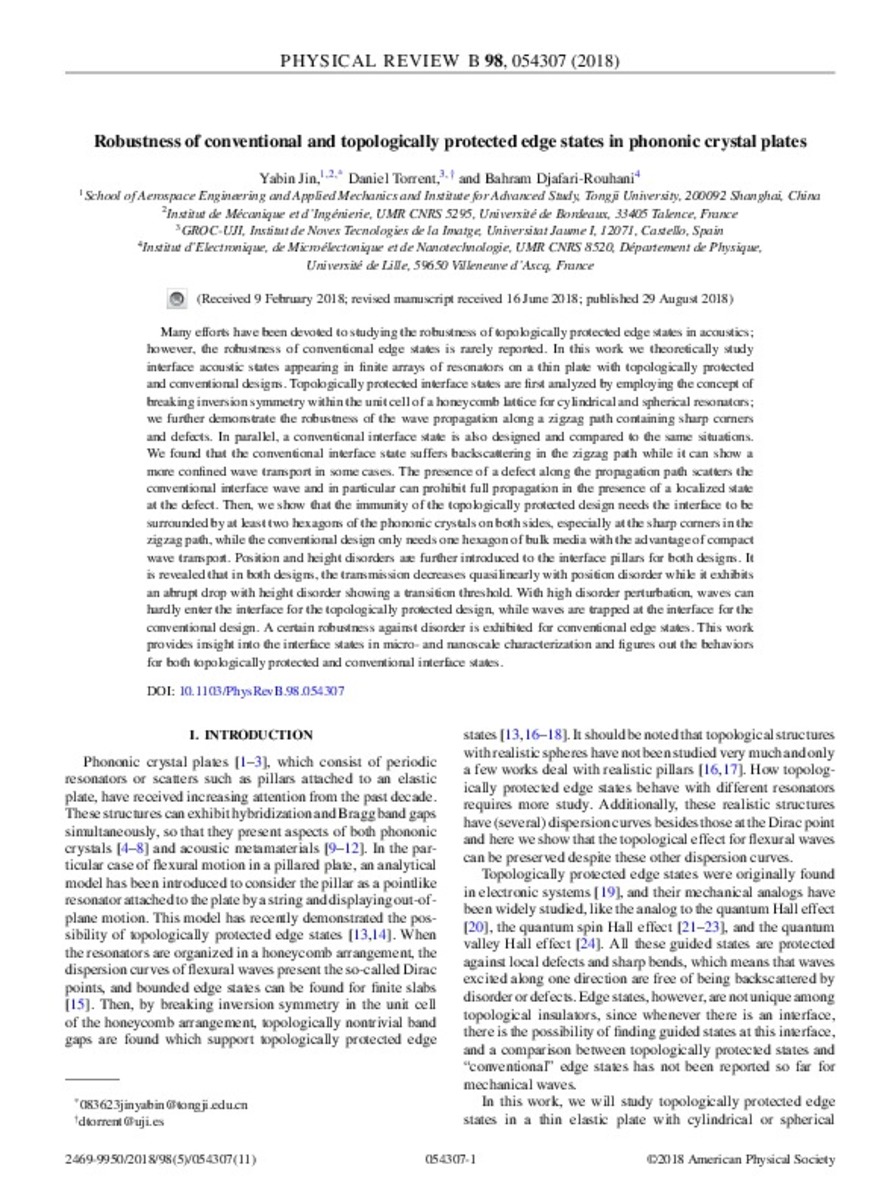Mostrar el registro sencillo del ítem
Robustness of conventional and topologically protected edge states in phononic crystal plates
| dc.contributor.author | Jin, Yabin | |
| dc.contributor.author | Torrent, Daniel | |
| dc.contributor.author | Djafari Rouhani, Bahram | |
| dc.date.accessioned | 2018-10-11T11:25:09Z | |
| dc.date.available | 2018-10-11T11:25:09Z | |
| dc.date.issued | 2018 | |
| dc.identifier.citation | JIN, Yabin; TORRENT, Daniel; DJAFARI-ROUHANI, Bahram. Robustness of conventional and topologically protected edge states in phononic crystal plates. Physical Review B, 2018, vol. 98, no 5, p. 054307. | ca_CA |
| dc.identifier.issn | 2469-9950 | |
| dc.identifier.issn | 2469-9969 | |
| dc.identifier.uri | http://hdl.handle.net/10234/176692 | |
| dc.description.abstract | Many efforts have been devoted to studying the robustness of topologically protected edge states in acoustics; however, the robustness of conventional edge states is rarely reported. In this work we theoretically study interface acoustic states appearing in finite arrays of resonators on a thin plate with topologically protected and conventional designs. Topologically protected interface states are first analyzed by employing the concept of breaking inversion symmetry within the unit cell of a honeycomb lattice for cylindrical and spherical resonators; we further demonstrate the robustness of the wave propagation along a zigzag path containing sharp corners and defects. In parallel, a conventional interface state is also designed and compared to the same situations. We found that the conventional interface state suffers backscattering in the zigzag path while it can show a more confined wave transport in some cases. The presence of a defect along the propagation path scatters the conventional interface wave and in particular can prohibit full propagation in the presence of a localized state at the defect. Then, we show that the immunity of the topologically protected design needs the interface to be surrounded by at least two hexagons of the phononic crystals on both sides, especially at the sharp corners in the zigzag path, while the conventional design only needs one hexagon of bulk media with the advantage of compact wave transport. Position and height disorders are further introduced to the interface pillars for both designs. It is revealed that in both designs, the transmission decreases quasilinearly with position disorder while it exhibits an abrupt drop with height disorder showing a transition threshold. With high disorder perturbation, waves can hardly enter the interface for the topologically protected design, while waves are trapped at the interface for the conventional design. A certain robustness against disorder is exhibited for conventional edge states. This work provides insight into the interface states in micro- and nanoscale characterization and figures out the behaviors for both topologically protected and conventional interface states. | ca_CA |
| dc.format.extent | 11 p. | ca_CA |
| dc.format.mimetype | application/pdf | ca_CA |
| dc.language.iso | eng | ca_CA |
| dc.publisher | American Physical Society | ca_CA |
| dc.relation.isPartOf | PHYSICAL REVIEW B 98 (2018) | ca_CA |
| dc.rights | ©2018 American Physical Society | ca_CA |
| dc.rights.uri | http://rightsstatements.org/vocab/InC/1.0/ | * |
| dc.title | Robustness of conventional and topologically protected edge states in phononic crystal plates | ca_CA |
| dc.type | info:eu-repo/semantics/article | ca_CA |
| dc.identifier.doi | https://doi.org/10.1103/PhysRevB.98.054307 | |
| dc.rights.accessRights | info:eu-repo/semantics/openAccess | ca_CA |
| dc.relation.publisherVersion | https://journals.aps.org/prb/abstract/10.1103/PhysRevB.98.054307 | ca_CA |
| dc.contributor.funder | Work supported by the US Office of Naval Research under Grant No. N00014-17-1-2445 | ca_CA |
| dc.type.version | info:eu-repo/semantics/publishedVersion | ca_CA |
Ficheros en el ítem
Este ítem aparece en la(s) siguiente(s) colección(ones)
-
INIT_Articles [747]







